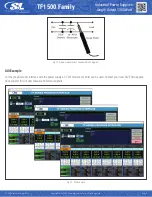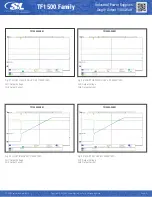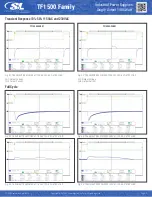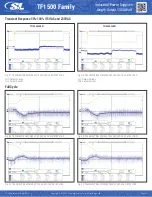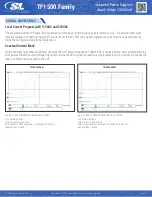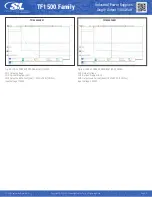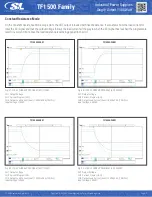
Industrial Power Supplies
Single Output 1500 Watt
TF1500 Family
TF1500 Application Note v1019
Copyright © 2019 SL Power Electronics Corp. All rights reserved.
Page 4
Grounding
TF1500 series have three types of accessible grounds. Each of these ground connections has dedicated purpose to maintain within
safety requirements or electrical characteristics stated in datasheet. Do not mix usage of these electrical contacts.
• Protective Earth (PE), marked as GND on AC input.
• The enclosure of power supply is directly connected to this electrical potential. Floating PE of the power supply may affect electro-
magnetic characteristics of the unit.
• Output Return, marked as (-) on DC output. Isolated from AC input, rated as SELV. This electrical potential is floating with respect
to protective earth. Contact local field applications support to verify usage of arrays within your application.
• Signal Return, marked as GND on the CN2 connector (Pins 6,10), used for control signals on CN2 connector only. This electrical po-
tential is a reference voltage for digital signals and control features on the power supply such as POK, AUX, ACI, VCI etc. Shorting
of this node to other ground may feed common mode noise into the control system and distort the functionality of digital control
or feedback loop.
Mechanical Mounting
Use proper mating connectors for connection to the input, output and signal connectors of the power supply. Use the provided screws
for AC and DC connection. If custom screws are to be used, pay attention to their length especially on AC side not to damage the
mounting. The recommendation is to use cable lugs for proper and secured connection.
TF1500 series power supply offer mounting options from the bottom and/or long sides of enclosure. Refer to the mechanical drawing
in the datasheet for detailed dimensions. Use M4 screws with maximum penetration of 3mm measured from the enclosure surface.
Ensure at least 50mm clearance at front and back side for proper ventilation.
Communication Setup I²C Bus Interface Option
Serial clock (SCL): This input signal is used to strobe all data in and out of the unit. It should be connected to +5V via a pull-up resistor
of 2KΩ. The I²C interface is designed to run with a serial clock speed of 100KHz.
Serial Data (SDA): This bi-directional signal is used to transfer data in or out of the unit. It is an open drain output that may be wired
with other open drain or open collector signal on the bus. A pull-up 2KΩ resistor must be connected from Serial Data (SDA) to +5V.
Communication Setup RS 232/RS 485 Interface Option
The UART Communication Interface is based on 3-wire connection where two signals RXD and TXD are used with a host PC and refer-
ence both to control ground. The UART communication protocol invariably uses 4800 Baud rate, no parity check, 8 bit data and 1 stop
bit (4800,N,8,1). This setting cannot be changed.
Output Ripple Measurement Method
• Output noise and ripple limits are defined in the product datasheet and may vary depending on the output voltage. Consult the
product datasheet prior to assessing the output ripple and noise measurement results.
• Noise measurements are made with noise probe directly at the end of 1.8m twisted pair wires terminated with a 0.1uF ceramic and
10uF electrolytic low ESR capacitors. Use a short tip oscilloscope voltage probe when making the measurement. This is required
to eliminate measurement error due to impedance imbalance errors introduced by the scope probe ground lead length.





